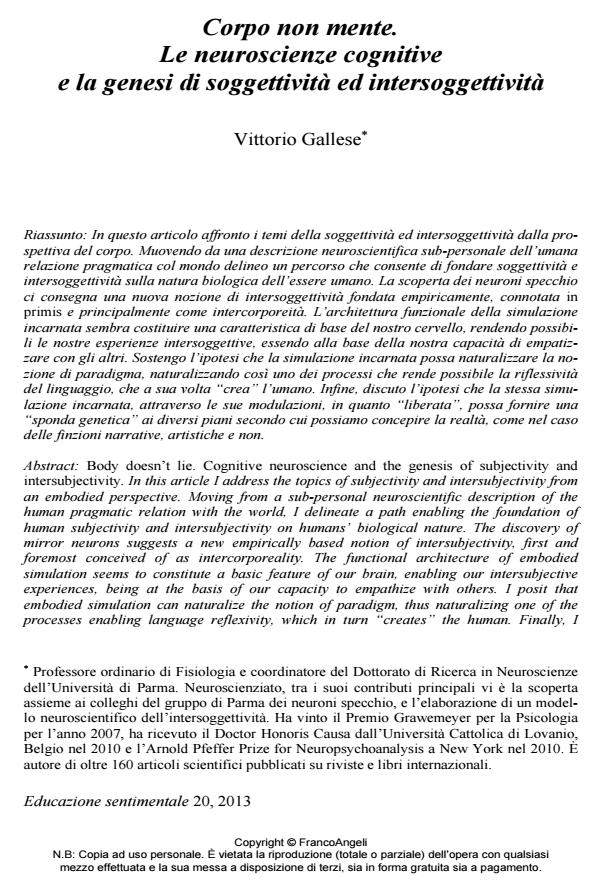Corpo non mente. Le neuroscienze cognitive e la genesi di soggettività ed intersoggettività
Titolo Rivista EDUCAZIONE SENTIMENTALE
Autori/Curatori Vittorio Gallese
Anno di pubblicazione 2013 Fascicolo 2013/20
Lingua Italiano Numero pagine 17 P. 8-24 Dimensione file 671 KB
DOI 10.3280/EDS2013-020002
Il DOI è il codice a barre della proprietà intellettuale: per saperne di più
clicca qui
Qui sotto puoi vedere in anteprima la prima pagina di questo articolo.
Se questo articolo ti interessa, lo puoi acquistare (e scaricare in formato pdf) seguendo le facili indicazioni per acquistare il download credit. Acquista Download Credits per scaricare questo Articolo in formato PDF

FrancoAngeli è membro della Publishers International Linking Association, Inc (PILA)associazione indipendente e non profit per facilitare (attraverso i servizi tecnologici implementati da CrossRef.org) l’accesso degli studiosi ai contenuti digitali nelle pubblicazioni professionali e scientifiche
In questo articolo affronto i temi della soggettività ed intersoggettività dalla prospettiva del corpo. Muovendo da una descrizione neuroscientifica sub-personale dell’umana relazione pragmatica col mondo delineo un percorso che consente di fondare soggettività e intersoggettività sulla natura biologica dell’essere umano. La scoperta dei neuroni specchio ci consegna una nuova nozione di intersoggettività fondata empiricamente, connotata in primis e principalmente come intercorporeità. L’architettura funzionale della simulazione incarnata sembra costituire una caratteristica di base del nostro cervello, rendendo possibili le nostre esperienze intersoggettive, essendo alla base della nostra capacità di empatizzare con gli altri. Sostengo l’ipotesi che la simulazione incarnata possa naturalizzare la nozione di paradigma, naturalizzando così uno dei processi che rende possibile la riflessività del linguaggio, che a sua volta "crea" l’umano. Infine, discuto l’ipotesi che la stessa simulazione incarnata, attraverso le sue modulazioni, in quanto "liberata", possa fornire una "sponda genetica" ai diversi piani secondo cui possiamo concepire la realtà, come nel caso delle finzioni narrative, artistiche e non.
Parole chiave:Arte, empatia, intersoggettività, linguaggio, neuroni specchio, paradigma, simulazione incarnata, soggettività.
- Il corpo paradigmatico. Simulazione incarnata, intersoggettività, Sé corporeo e linguaggio Vittorio Gallese, Valentina Cuccio, in SETTING 43/2020 pp.5
DOI: 10.3280/SET2020-043001 - Empathy Vincenzo Auriemma, pp.89 (ISBN:978-3-031-38859-0)
- Neurochange. Dall'antropologia culturale alle neuroscienze. Un'ipotesi di lavoro e un caso di studio supportato dall'utilizzo delle rilevazioni neurometriche, per la gestione dei processi di cambiamento nelle istituzioni economiche e sociali Massimilano Santoro, in RICERCHE DI PSICOLOGIA 3/2017 pp.313
DOI: 10.3280/RIP2017-003003 - Intrecci e metamorfosi fra passato, presente e futuro: l'approccio ecologico sociale e umano agli eventi di natura traumatica, ai processi di resilienza e alla resilienza assistita Elena Malaguti, in RIVISTA SPERIMENTALE DI FRENIATRIA 3/2016 pp.83
DOI: 10.3280/RSF2016-003007 - Lifelong Learning - Education for the Future World Paola Damiani, Davide Brancato, Filippo Gomez Paloma, (ISBN:978-0-85014-117-7)
- L'uso delle immagini e della fotografia nella psicoterapia della Gestalt. Neuroestetica, neuroni specchio e risonanza corporea Michele Cannavò, Jelena Zeleskov Doric, Alessandro Cereda, Azzurra G.M. Alù, in QUADERNI DI GESTALT 2/2021 pp.29
DOI: 10.3280/GEST2021-002003 - Embodied intersubjectivity: Forms of psyche-soma structuring in the encounter between self and other-than-self* Anna Ferruta, Maurizio Stangalino, in The International Journal of Psychoanalysis /2024 pp.455
DOI: 10.1080/00207578.2024.2362807 - More than spectators, visionaries Laura Marcolini, in AN-ICON. Studies in Environmental Images [ISSN 2785-7433] /2024 pp.97
DOI: 10.54103/ai/25154 - Le due porte d'ingresso dell'ipnosi nelle dipendenze patologiche: l'alessitimia e la memoria del piacere Nicolino Rago, Federica Volpi, Mario Marazzi, in IPNOSI 1/2021 pp.27
DOI: 10.3280/IPN2021-001002 - Goldman and His Critics Vittorio Gallese, pp.297 (ISBN:9780470673676)
- Passato, presente e futuro dei disturbi di conversione: una comprensione e ridefinizione neuropsicologica dell’unità corpo-cervello-mente Michele Di Salvo, in Ricerca Psicoanalitica /2025
DOI: 10.4081/rp.2025.1047 - Phenomenology of Suicide Davide Donelli, Matteo Rizzato, pp.73 (ISBN:978-3-319-47975-0)
- Dare voce al soggetto. Materiali tratti dall'osservazione longitudinale di un bambino autistico Maria Pediconi, Luca Regini, in Ricerca Psicoanalitica /2021
DOI: 10.4081/rp.2021.313
Vittorio Gallese, Corpo non mente. Le neuroscienze cognitive e la genesi di soggettività ed intersoggettività in "EDUCAZIONE SENTIMENTALE" 20/2013, pp 8-24, DOI: 10.3280/EDS2013-020002